
Patrick Brown - Missouri Department of Mental Health
?Twelve years with the Missouri Department of Mental Health has given Housing Consultant Patrick Brown a deep appreciation for collaboration. This was confirmed in the wake of Hurricane Katrina, with some 4,000 evacuees and counting forced to relocate their lives and families to a new city. “Kansas City is an easy town to pull together projects and collaborate, even before the hurricane,” Brown says, “but Katrina showed Kansas City at its finest.”
Growing up in the Appalachia region of Ohio, and witnessing the poverty of many of those around him, Brown knew early on that he wanted to help people in these situations, that “people don’t have to live without homes.” Through his work with the Department of Mental Health, Brown works with the state and other local agencies to provide subsidies and grant funding for affordable housing for low-income individuals and families with disabilities.
Two days after Katrina hit, Brown’s department was asked by Mayor Barnes to help pull together resources and organize a task force to help with financial and housing situations for the thousands of evacuees expected to be coming to Kansas City from New Orleans. Working with the Kansas City Housing Authority, Children’s Mercy Hospital and other organizations, Brown helped set up an information referral system to determine client needs, from those needing wheelchair-accessible units to appropriate employment prospects for evacuees intending permanent relocation. Brown recalls helping one single mother with three kids, two of them in wheelchairs, locate a handicap-accessible apartment in a suitable neighborhood in Shawnee County with a school providing special education needs.
Through it all—and Brown expects more evacuees to come—the level of community collaboration from businesses, agencies and individuals has been extraordinary. “That was what was fascinating,” says Brown, “the resources that were localized were unbelievable. Once you get the supply line started, the word gets out. I didn’t have to beg to receive anything—it just showed up at our door.”
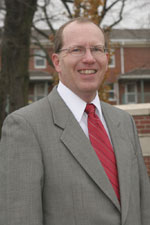
Edwin Lowndes - Kansas City Housing Authority
?Intended or not, Edwin Lowndes is fully aware of the pun when he says of the hurricane evacuees, “We gave them a foundation to put their lives back together.” As Executive Director of the Kansas City Housing Authority (KCHA), Lowndes has spent 10 years helping to provide housing to low-income families. When Katrina hit New Orleans and instantly made thousands of families homeless, Lowndes knew it was only a matter of time before many of these displaced families would be coming to Kansas City seeking temporary and permanent shelter—and he knew the city had to be ready.
Because of the nature of the disaster in New Orleans, Lowndes and the multiple organizations he worked with were able to speed up a screening and housing assistance process that typically takes anywhere from one to three years. “Our goal was to get away from the bureaucracy and find a way to expedite the process to help these families,” Lowndes says. “The best way to cut down the bureaucracy was to work directly with the families.” And that meant determining “how many families need housing and how we can assist them. Some of these people literally lost everything. They went from low income to no income.”
The Kansas City Housing Authority pulled together other area public housing authorities and was designated the main center of operations in issuing rental assistance program applications for vouchers to evacuees looking for homes. The KCHA worked with area landlords in pre-inspecting 150-200 apartments for incoming families. They also agreed to waive security deposits until families who had lost everything in the hurricane could afford to pay.
At the same time, Lowndes and his staff continued to assist the 10,000 people already on the KCHA’s waiting list before the hurricane. Between September and October, more than 300 vouchers were offered to families, half of these going to Katrina evacuees. Of the massive collaborative effort staged by the KCHA and other area organizations, Lowndes says, “We saw the need in families who lost everything. When you put your mind to it, you can really mobilize and help people out.”

?Edward Collins – KCMO Fire Dept. (retired), Parking Plaza @ KCI
?Edward Collins, former Battalion Chief of the Kansas City Fire Department, says about his part in the Katrina response, “There were so many people involved in this effort, I don’t consider myself a hero.” Just the same, after the hurricane hit New Orleans and the grisly aftermath became vividly apparent on the TV news, Collins, like many others, knew he “couldn’t sit and watch and do nothing.” He soon found himself thrust into the spotlight after a television interview asked for his opinion, based on his 17 years of fire-fighting experience, on the evacuee situation. “My response,” Collins says, “was they’re gonna need homes and they’re gonna need jobs.”
Collins worked with the fire department until a year ago, when a fire-related injury suffered in the line of duty forced him to take an early retirement after months of surgery and rehabilitation. He now oversees operations of The Parking Plaza at KCI Airport. When word of the television interview got around, Collins began receiving phone calls and e-mails, not just from concerned Kansas Citians, but from people all over the country, some requesting help and others volunteering to house evacuated families.
Working with Scott White of Executive Travel, Catholic Charities, the Red Cross and other local and national organizations, Collins helped develop and manage a database for volunteers offering housing space for evacuees. A housing profile was designed for host residences to identify the number of people they could house, whether transportation provisions could be arranged, if handicap-accessible facilities were available and other information. In a short matter of time, over 250 host homes responded, with a capability of housing over 1,000 people. With further assistance from several local auto businesses, transportation was even provided for several families. “We basically became a conduit for these people needing homes,” Collins says of his group’s “grassroots effort” to provide semi- and permanent shelter for hurricane evacuees.
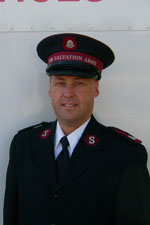
Major Mark Martsolf - Salvation Army of Topeka
?“Overwhelming.” That’s the one word Major Mark Martsolf uses to describe his initial reaction after witnessing, first-hand, the devastating results of Hurricane Katrina. “I’ve been to a lot of disasters in my 25 years […] but I’ve never seen anything like the size or the magnitude [of Katrina]. I was completely overwhelmed by the scope of it.”
Before going to the Gulf Coast, Major Martsolf, a Core Commanding Officer for the Topeka branch of the Salvation Army, and his staff of 27 worked with FEMA and other local organizations to set up procedures at the Civic Arena for an expected 1,500 evacuees. When the anticipated number of evacuees did not meet the original projection, Martsolf helped coordinate a massive food and supplies drive with local television and radio stations. Clothing, diapers, canned goods and other essentials were gathered in a warehouse and shipped all over the Gulf Coast region to needy families.
On September 17, Martsolf was deployed to La Place, Louisiana, about 16 miles from New Orleans, where he served for two weeks as Public Relations Information Officer while also managing Chaplain duties. Aside from being responsible for all communications with the media, Martsolf helped with disaster relief efforts—mainly distributing food and water and providing ministry to hurricane victims and other relief workers. He recalls the number of hot meals served to victims and workers rising from 15,000 to 30,000 a day during his deployment, and adds that at least 20,000 people a day are still being served now.
But, according to Martsolf, more than just being fed, “People so wanted to talk, to share their experiences with somebody.” With the devastation all around him, Martsolf admits thinking at first, “We can’t even make a dent, the destruction’s so big.” But, seeing the thankful faces of evacuees and relief workers alike all around him, Martsolf says he realized “how grateful people were for a hot meal, a listening ear, a shoulder to cry on. When you’re dealing with that magnitude and scope—you have to believe our efforts make a difference.”
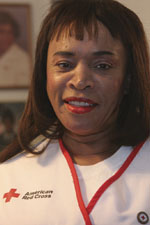
?Dorothy Weathers – American Red Cross Kansas City Chapter
?“There were buses to make you cry—buses as far as your eyes could see.” Dorothy Weathers watched the first 11 buses pull up just three hours after she and her small team of Kansas City Red Cross volunteers arrived at the Houston Astrodome to help make emergency shelter preparations. Weathers’ group of five was the first one there, and they encountered a giant, empty stadium with no food, water, beds or even towels to greet the onslaught of tired and hungry evacuees. Weathers and her team arranged for a trailer from a nearby Wal-Mart distribution center to deliver water, blankets, toothpaste and other necessary supplies. By the second day, area churches were responding, and within five days of Weathers’ arrival, some semblance of organization began to formulate, even as the buses continued to roll in with more evacuees. Over 96,000 people ended up seeking shelter in the Astrodome, well over 30,000 more than the maximum occupancy.
For more than two weeks, Weathers stayed at the Astrodome and helped in whatever ways she could. This included assisting mothers with small children and older evacuees, many in wheelchairs, and collaborating with local and national officials. Above all, Weathers acted as a reassuring presence and simply talked with the frightened and desperate evacuees who continued to pile into the stadium. She says she would “just sit and talk with people, get them to relax. God didn’t just look at people and watch them. You could tell people were hurting by looking in their eyes.”
Weathers has been a Red Cross volunteer since 1978, serving in both New Orleans and Mississippi as well as Kansas City. She has had prior experience responding to hurricane relief, but nothing half as devastating as the Katrina aftermath. “I’ve never seen so much suffering in all my life,” Weathers recounts, “It was a life-learning experience.” Her devotion to volunteerism is reflected in her knowledge that there is still much work to be done along the Gulf Coast. “I’d like to go back, maybe in the springtime,” she says, “and see what I can do.”
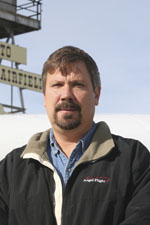
Greg Kaaz - Angel Flight Central
?“To give something back,” Greg Kaaz says of the motivation that inspires him in his work with Angel Flight Central (AFC). “To be able to give something back to the community, back to society. It’s a hands-on, face-to-face dealing with people—to know you’ve really affected their lives—something you can’t put a monetary figure on.”
Kaaz has been a volunteer pilot and, up until August, board member with Angel Flight Central for 10 years. He works on a limited on-call basis and typically flies one mission a month, at his own expense. These are generally scheduled flights for special-needs patients with doctor appointments in other states who can’t afford to travel. When Hurricane Katrina swept through New Orleans and scattered families all along the Gulf Coast, Kaaz, along with some 700 other volunteer pilots with AFC (in addition to the scores of volunteers from Angel Flight agencies all over the country), found the need for on-call volunteer missions considerably increased.
Besides flying volunteer doctors and nurses from Heart to Heart International to and back from New Orleans, Kaaz says, “A lot of missions we did were reuniting families after the hurricane, families who didn’t have funds to travel to Kansas City.” Kaaz recalls two families in particular, both of them with infant children who were flown to Children’s Mercy Hospital in Kansas City. One child was a newborn with leukemia. In both cases, the parents came along and stayed at the hospital with the babies while their other kids remained behind, one group staying with an aunt in Alabama and the other left behind in St. Charles (where, consequently, they had to brace themselves a second time for Hurricane Rita). Kaaz was eventually able to fly the kids to Kansas City and, after weeks of separation, reunite them with their parents.
Kaaz is realistic about using his ability to fly to volunteer with Angel Flight. “Rather than flying somewhere to get a burger or something,” he says, “it makes a lot more sense to help somebody out. It’s really a win-win. The level of satisfaction is so high.”
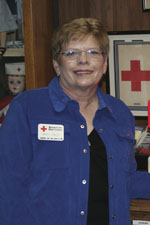
?Marty Finley – American Red Cross Kansas City Chapter
?Red Cross volunteer Marty Finley was one of a group of four sent from the Greater Kansas City Chapter of the American Red Cross to Washington, D.C. to train and help run an Emergency Response Center in Kansas City in the aftermath of Hurricane Katrina. It was the first time a call center in KC had been instigated specifically for hurricane relief. In training for just a few hours, Finley was put to work immediately, training other local chapter staff members. A week later, she was taking live calls from people looking for loved ones displaced by the hurricane, evacuees seeking the nearest shelter sites and other people whom Finley helped get “onto the road to recovery.” For 12 hours a day, seven days a week, Finley worked the phones and helped supervise activities at the call center, logging in 556 hours since it opened on September 9.
Since joining the Red Cross with her husband in 1997, Finley has contributed over 4,700 hours volunteering with the organization’s Disaster Action Team and the Homeless Feeding Program. She recalls cooking meals and loading cars on Friday nights and going out with her husband, daughter and others to feed hot meals to the homeless in the Kansas City area.
Hurricanes Katrina and the subsequent Rita presented a new, daunting challenge for Finley and the other volunteers operating the 10 call center stations across the U.S. Her main concern was trying to get as many people in shelters as possible, where they would be served three meals a day and treated to on-duty doctors and nurses. She worked with local authorities in New Orleans to help make arrangements for families without insurance to be able to afford hospital stays for their small children. Throughout the ongoing relief efforts, Finley found motivation from her fellow volunteers and the hurricane victims themselves. “It’s really inspiring,”she says, “the spirit and the strength and the fortitude of people who’ve lost so much in Katrina. I have a real admiration for all the American Red Cross volunteers.”